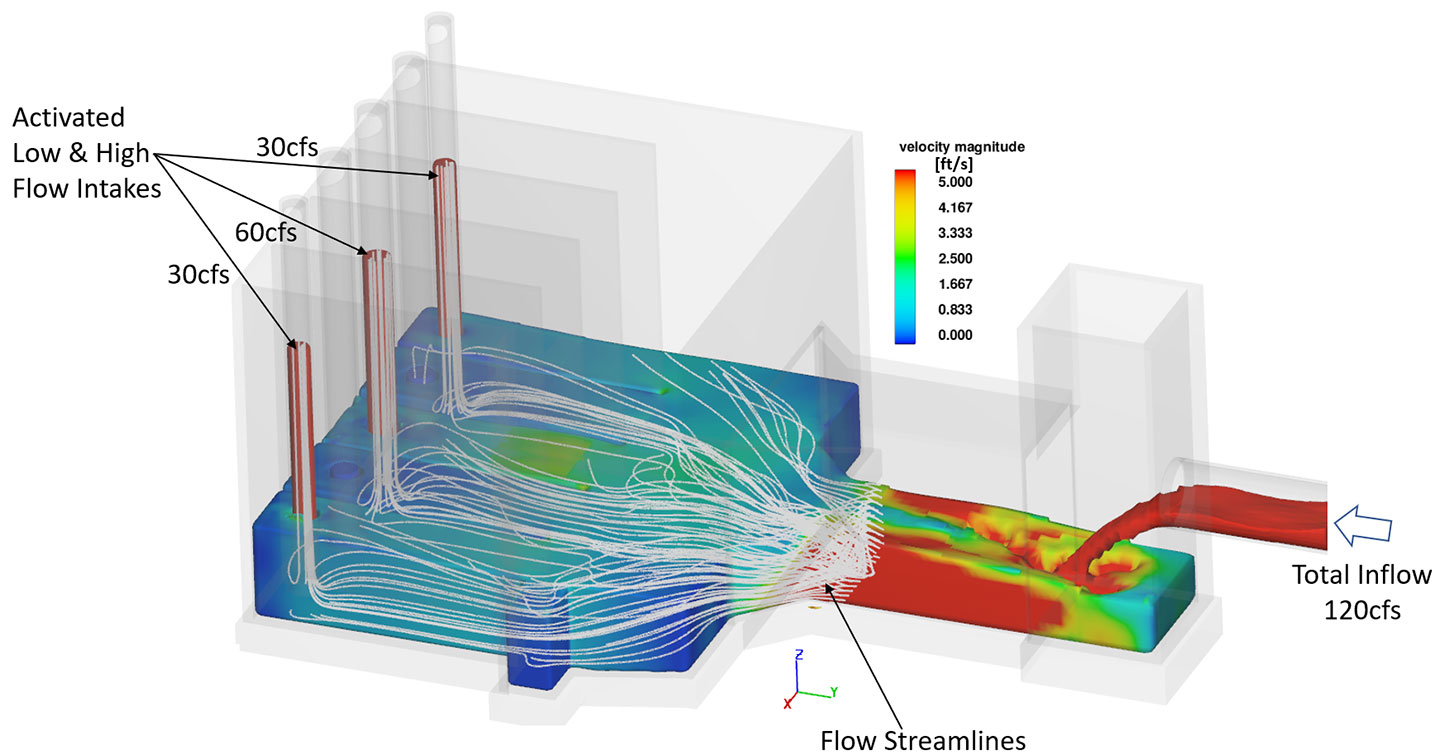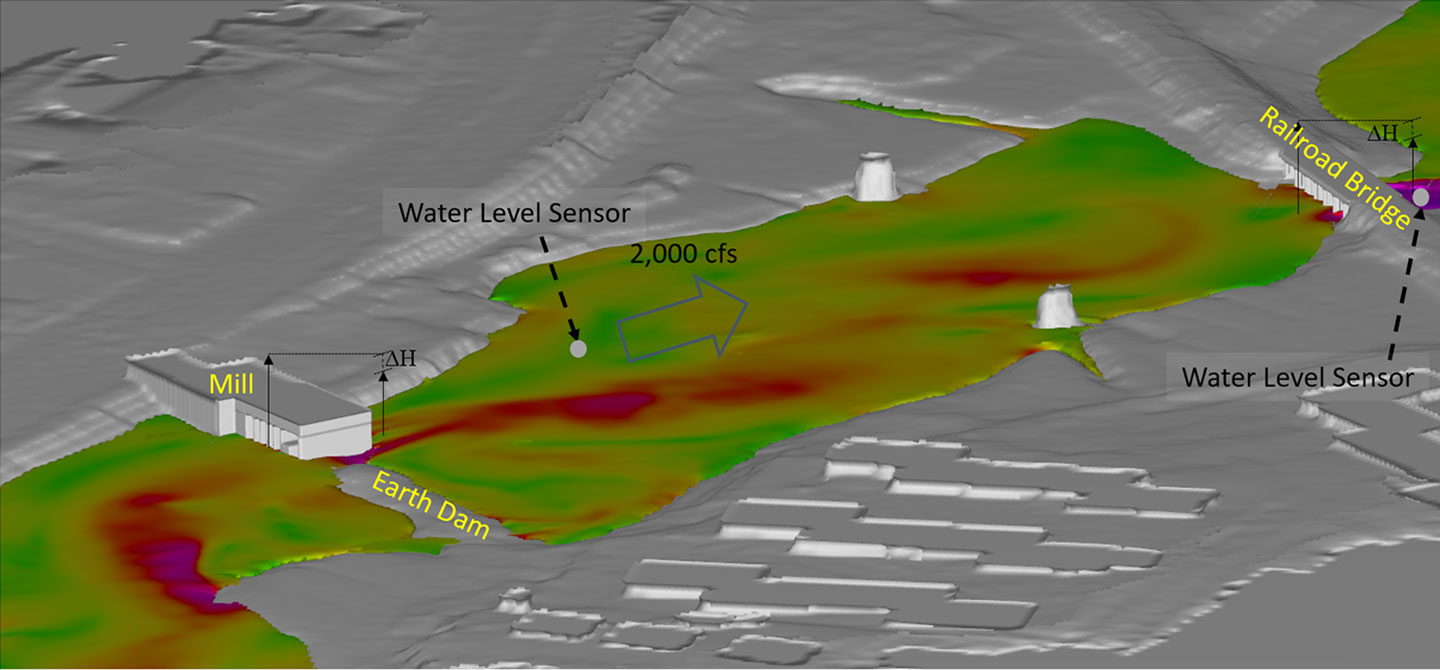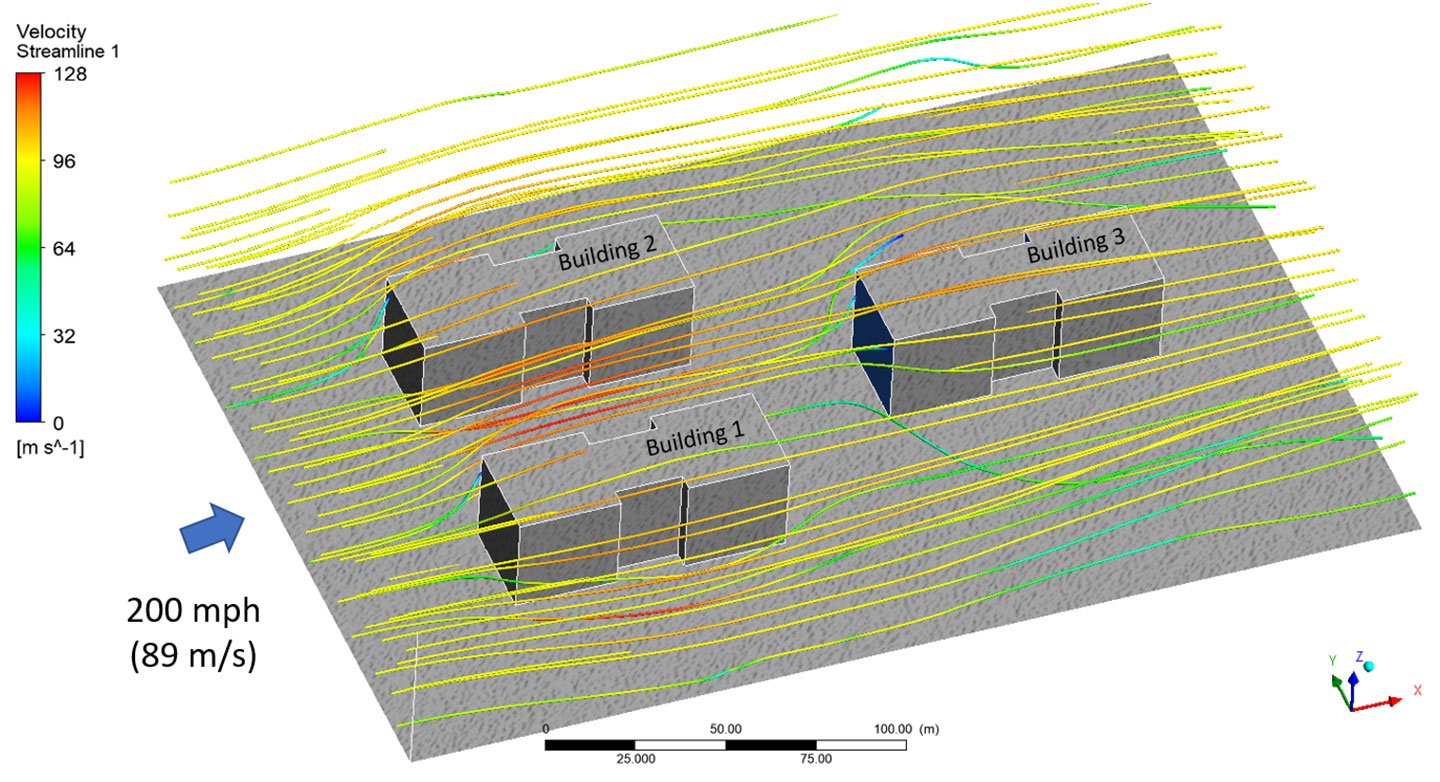Tracking the motion of fluids and understanding how fluids interact with their surroundings are very important elements of water and environmental engineering, but how do engineers calculate and visualize flows? Computational fluid dynamics (CFD) is a
branch of fluid mechanics that uses numerical analysis to solve the equations of fluid motion in three dimensions (3D). CFD analyses can also be done in two dimension (2D); however, herein we refer to CFD in 3D, which is most commonly used in most
industrial applications. The technique uses software to visualize the flow of fluids such as water and air within and around natural and artificial structures or terrains. The visualized data is used to interpret how fluid particles interact with
their surroundings and can aid engineers in their project designs.
Five Applications of CFD
CFD can be used in a wide variety of engineering applications ranging from building structures to water and wastewater infrastructure projects. Some of the primary applications of CFD in our firm’s work include:
- Designing for new or retrofitting existing water pump stations
When we are designing a new pump station that will discharge to a pipe, river, or lake, one of the main objectives of the designer is to minimize potential head losses and uneven flow distributions in order to optimize system performance. Asymmetric
flows approaching pump intakes can lead to high-flow instabilities in the vicinity of pump blades causing, in many occasions, significant vibrations that might lead to either total blade collapse or pumping efficiency reduction, at the very
least. With the help of CFD, we can devise geometric configurations to modify how the flow approaches the pumps, optimize it, and enhance its uniformity to reduce turbulence on its way to the pump blades. To accomplish this, we can look at
modifying the transition between the inlet conduits and the wet well, as well as the addition of guide walls and bottom seals to minimize recirculation zones and flow unevenness into and within the wet well.
A prime example of this is a CFD study we performed for a client in the central valley region of California, where we used CFD to aid the design of a new pump station intake. Headlosses and flow unevenness were minimized via geometric modifications
of the inlet channel and guide walls within the wet well. Pump operational levels were optimized to reduce the potential formation of undesired free surface and subsurface vortices that could threaten the optimum performance of the pump station.
 Pump intake operational and geometric optimization using CFD.
Pump intake operational and geometric optimization using CFD.
- Estimating head losses and the capacity of hydraulic structures in streams
We also evaluate the conveyance capacity of hydraulic structures such as bridges and box culverts. For instance, in the case of bridges, CFD can provide an accurate description of the head losses through the structure and, ultimately, the hydraulic
capacity of the bridge, i.e., the maximum discharge that can be transferred from upstream to downstream without overtopping the bridge deck.
If there is a heavy rainfall event upstream of that bridge, we can use CFD to estimate the maximum amount of water that can pass through it. The design team is often tasked to confirm that the bridge can pass a flow discharge for a specific design
storm event, like a rainfall with a 25-year return period. If the event is bigger than the one that the bridge is able to accommodate, we use CFD to determine alternative designs to retrofit or modify the bridge.
 Evaluation of Conveyance Capacity of Hydraulic Structures using CFD.
Evaluation of Conveyance Capacity of Hydraulic Structures using CFD.
- Optimizing flow distribution in wastewater treatment plants and the effectiveness of treatment units
CFD can be used to help designers optimize different water treatment units, such as aeration tanks, grit chambers, equalization basins, primary and secondary clarifiers, and filtration units. For example, CFD is used to optimize the sediment trapping
efficiency of grit chambers by designing geometric configurations that promote grit settling by enhancing flow circulation patterns within the unit by modifying the inlet and outlet conduits. By optimizing flow velocity patterns, solids
will deposit at the bottom of the grit chamber more effectively. This process helps to enhance sediment trapping efficiency in a very cost-effective manner, by reducing, and not eliminating, the need for physical modeling testing iterations.
 Simulated flow velocity contour and particle propagation in a clearwell under equal inflow and outflow of 2MGD after 1,000 seconds.
Simulated flow velocity contour and particle propagation in a clearwell under equal inflow and outflow of 2MGD after 1,000 seconds.
- Calculating the deposit of pollutants in a given body of water
When we evaluate stormwater runoff, such as in a stream, there could be runoff coming from both rural and urban tributary areas. This runoff is usually accompanied by pollutants, such as nitrogen, phosphorus, and even oils that enter the stream.
For example, native fauna and flora in marshes along tidal creeks may be greatly endangered by such pollutants, especially when these are not evacuated efficiently. The CFD allows us to estimate how long it will take for those pollutants to
deposit to the bottom of the stream or if they will be carried out by the flow downstream. This depends on how high or low the flow velocities are as a function of sedimentation processes along the stream. CFD modeling can assist the design
of measures to promote the effective flushing of pollutant away from marsh areas and ultimately optimize the efficacy of proposed stream restoration efforts under present and future precipitation and sea level conditions.
 Simulated saltwater intrusion in a tidal creek during storm surge conditions.
Simulated saltwater intrusion in a tidal creek during storm surge conditions.
- Estimating wind forces on buildings
CFD has become an effective tool that helps architects and civil engineers in the understanding of flow patterns around buildings and forces on landscape assets. In this manner, CFD simulations are used to aid in the optimization of architectural
assets by seeking to minimize damaging effects under extreme winds and comply with design codes and standards. CFD is also used to evaluate pedestrian comfort in urban areas and to estimate drag coefficients and forces on bridges.
 Simulation of wind forces on buildings.
Simulation of wind forces on buildings.
What’s Next for CFD?
One of the exciting next steps in the evolution of using CFD tools is to enhance its reliability in sediment transport studies evaluations and pollutant tracking. The challenge with using CFD for these applications is that it isn’t as simple as
a “plug and play,” since it requires extensive model calibration and validation. The interaction of fluids with other elements like pollutants, solids, or other particles carries out considerable levels of uncertainty in the data and modelling.
To respond to this uncertainty, in many cases we’ve used physical testing to calibrate and validate our numerical models. While we have made great strides in research for developing models for cohesive and non-cohesive sediment transport and
particle dynamics, the need remains to go to the laboratory, build a scaled model, and validate the numerical model. Fortunately, with each study, numerical schemes are improving over time as more data becomes available, and more literature is produced
with studies and findings that can be used to support CFD development.
Bringing the Analysis Tool to More Engineers Worldwide
In addition to my role at Dewberry, I serve as the chairman of the computational fluid dynamics committee for applications in water, stormwater, and wastewater treatment for the American Society of Civil Engineers (ASCE). The job of this committee is
to disseminate and to promote the use of this CFD to engineering practitioners. I'm currently leading an effort to create a manual of best practices in CFD which will help engineers to better use CFD to aid design engineers in solving complex fluid
flow problems in the water industry.